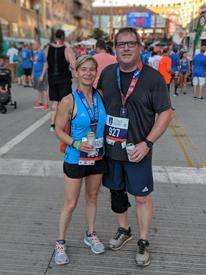HR Tracking/Training 101
Replies
-
Starflight00 wrote: »It's been quiet here for a while, but just my humble 2 cents. Last year I did a fitness test where they basically let you run on a treadmill till you drop while measuring lactic acid in your blood every 5 minutes or so. Then they estimate HR zones. Best money ever spent, as it's the most accurate measurement.
I'd be willing to spend the money, but I don't think I'm willing to run on a treadmill for a couple of hours to get an accurate LTHR.
It takes an hour at most as they're gradually increasing resistance to the point when you have to run 15 km/h uphill. Think most of my colleagues (some really fit) didn't make it past 45 minutes.0 -
PastorVincent wrote: »Starflight00 wrote: »It's been quiet here for a while, but just my humble 2 cents. Last year I did a fitness test where they basically let you run on a treadmill till you drop while measuring lactic acid in your blood every 5 minutes or so. Then they estimate HR zones. Best money ever spent, as it's the most accurate measurement.
How much did it cost you?
It was 190€ for the test + 50€ for a bodyscan to establish body composition. I'm in Europe though, no idea how much it costs in the US...0 -
Starflight00 wrote: »PastorVincent wrote: »Starflight00 wrote: »It's been quiet here for a while, but just my humble 2 cents. Last year I did a fitness test where they basically let you run on a treadmill till you drop while measuring lactic acid in your blood every 5 minutes or so. Then they estimate HR zones. Best money ever spent, as it's the most accurate measurement.
How much did it cost you?
It was 190€ for the test + 50€ for a bodyscan to establish body composition. I'm in Europe though, no idea how much it costs in the US...
Bah, was hoping you were in US, cause medical here is way wackier in pricing then over there. Probably 10 times that cost here.0 -
PastorVincent wrote: »Like the others, I have gone back almost 100% to running by feel, but I still have the zones set up in Strava for after run reports. I am leaning towards the opinion that we are approaching information overload on all this running data. I mean in the end, on race day, only finish time matters. None of the rest of the stats count.

So I watch pace and distance now primarily. Trying to get to the point 8:50 feels like a comfortable run so that it can be my Marathon Pace.
I agree. I spent some time training with my HRM when I first read "80/20 Running", but that was mostly just to get an idea what "easy" running should feel like. I am not sure that I ever really nailed down my actual lactate threshold heart rate, but it was close enough to set up some zones that worked to help keep me at an easy pace. I learned that I had been running too fast and I also learned that a HRM is pretty much useless for anything other than steady state runs at an easy pace, so once I got a pretty good feel for what that was, I ditched the HRM. Mine is a chest strap, so I prefer not to use it if I don't have to. Every once in a while I will bust it out just to see where my HR is on my easy runs and I believe it is on target with where it should be. In a way, I think a HRM is kind of like "training wheels" to teach you how to run at the correct PRE.3 -
_nikkiwolf_ wrote: »Having just read Fitzgerald's 80/20, I also started thinking about proper training zones recently.
Fitzgerald's book was the first explanation of heart rate zones that made sense to me. My Garmin 635 automatically sets zones and they seem to correlate pretty well with what I'm feeling. Heart rate technology (including the comfort of the chest strap) has improved a lot, so if you tried it 5-6 years ago, it might be worth revisiting it.0
This discussion has been closed.



